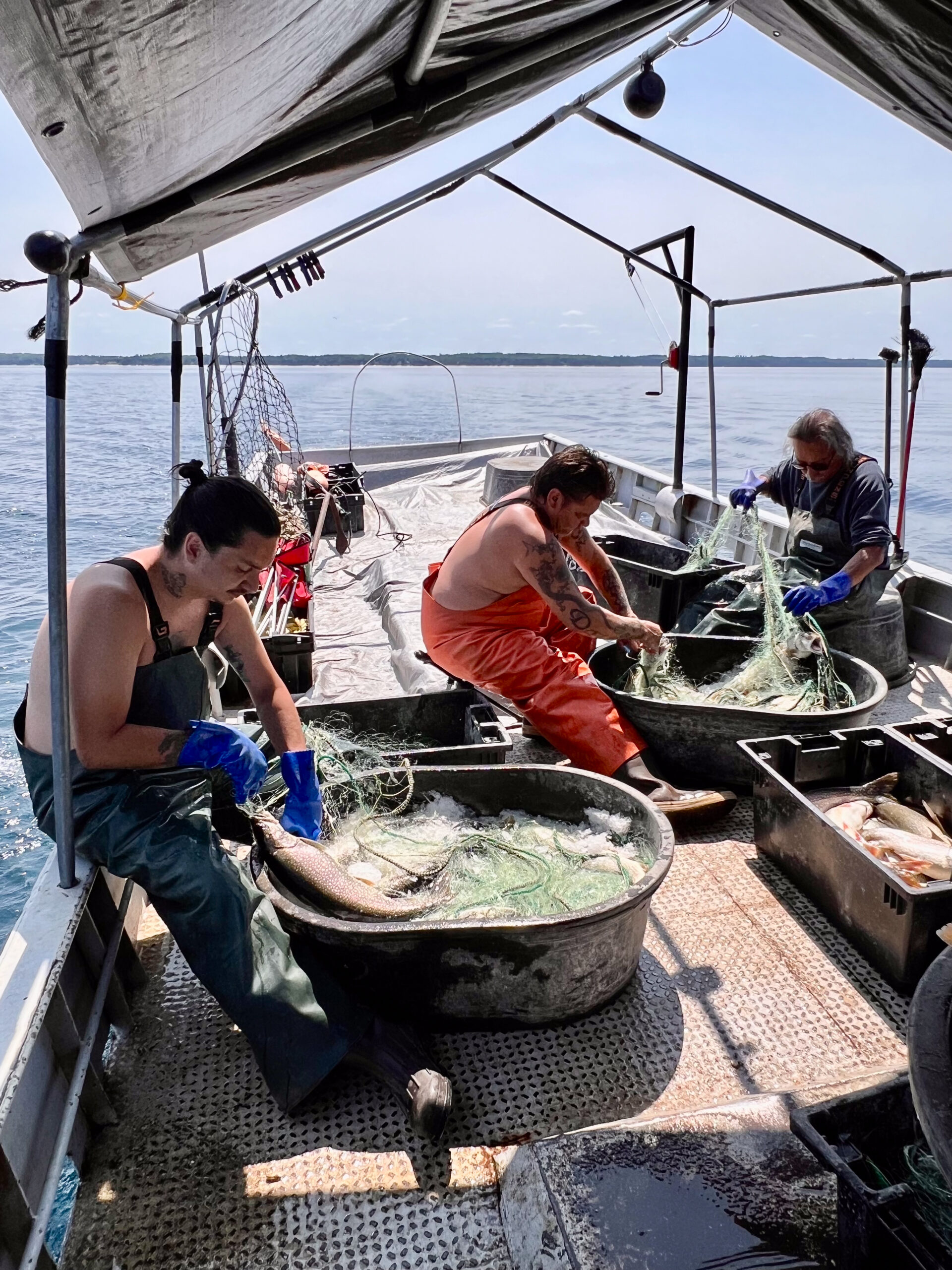
For the John/Ogemagegedo family, weekdays at the Arthur Duhamel Marina in Peshawbestown (Grand Traverse Reservation, within the borders of Michigan) mean catching, processing, and smoking fish. They run Treaty Fish Co., so named for the treaty fishing rights they exercise as members of the Grand Traverse Band of Ottawa and Chippewa Indians.
Proprietors Ed and Cindi John started the business in 1989. Ed learned to fish and hand tie nets from the marina’s namesake. Cindi learned to prepare smoked fish in traditional Anishinaabe ways from her uncle Jeeboo Sands, using local sugar maple wood to achieve their desired flavor.
In Grand Traverse Bay, the sought-after catches are lake trout and whitefish. In an industry that is heavily regulated by federal, state, and tribal governments, Ed and Cindi use their business as a vessel for family and community togetherness, an expression of Anishinaabe identity, and a way to connect with the water they love so deeply.
A Family Practice
The main crew of their 1940s fishing tug, Linda Sue, is Captain Ed, Cindi, their daughter Ruby, nephew Cameron Schocko, and family friend Shahbaht Anderson. The team leaves around 10:30 am with country and bluegrass music blasting. Cindi completes the calculations for net placement using GPS equipment, radar, and her knowledge of fish migrations patterns and the various depths and ridges that lie below the surface of Lake Michigan.
CINDI JOHN, TREATY FISH CO.“I do this all so I can be on the water. Can’t you smell it? Can’t you feel it? It’s special.”

We headed to what Cindi calls “Whitefish Acres” off Old Mission Peninsula. Anderson and Schocko pulled the anchor into the boat, and the net emerged from the depths. As it came aboard, Cindi stood near the edge with a dip net to catch any falling fish.
All told, they pulled 900 feet of net, yielding 200 pounds of fish. Some days they catch as much as 700 pounds. Everyone paused in the glittering sunshine of the bay to carefully and quietly remove the fish from the nets. Ruby drove the boat toward the marina and said she’d love to captain a vessel someday, with a solid crew like the people behind her.
Once ashore, each member of the family has a specific job. Schocko guts trout while Ed filets whitefish. Ruby removes the pin bones and prepares fish patties. Cindi handles “chunking” (portioning trout for the smoker), brining, and running the smoker. She also tends their weekly market stall at Sara Hardy Farmers Market in Traverse City. Nephew Daniel Genereaux untangles the nets and prepares them to be reset while Anderson and Schocko replace worn out netting and sew in new mesh. Other nephews gather during the week to clean the fish processing area and sanitize coolers and equipment.







A Special Connection
Treaty Fish Co. is a community hub—a result of the quality of their product and the spirit of the family. While I was there, at least three different people came looking for fish even though it wasn’t a day they were actively selling. Cindi told an elder, who was letting his dog swim at the marina, to grab a cooler to take home some fish.
Cindi’s passion for community and creativity shine through. She designs the packaging, working with FDA officials to both adhere to regulations and to ensure the finest product possible. In fact, the new marina fish processing facilities were designed based on the camping trailer Cindi had retrofitted, using her knowledge of federal health regulations as well as smooth division of labor.
Recently, the fishery joined the 100% Fish Great Lakes Pledge, which commits them to using 100% of their product in zero-waste ways. Cindi showed me some sunflowers she was growing next to the fish processing building (where she poured leftover fish juice); they were four times the size of those a friend was growing.
When asked what they love most about their work, both Cindi John and Cameron Schocko said it was being in the bay. Cindi said, “I do this all so I can be on the water. Can’t you smell it? Can’t you feel it? It’s special.”
